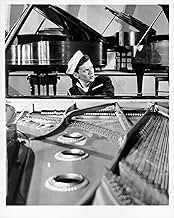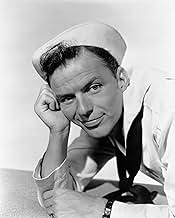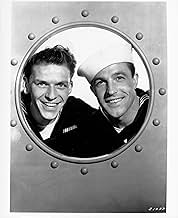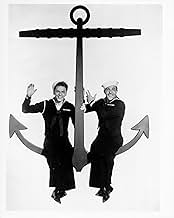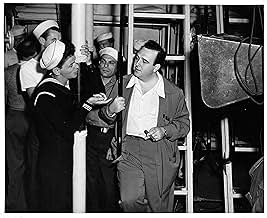NOTE IMDb
7,0/10
9,8 k
MA NOTE
Deux marins en congé à Hollywood tente d'aider une figurante à devenir une star de la musique.Deux marins en congé à Hollywood tente d'aider une figurante à devenir une star de la musique.Deux marins en congé à Hollywood tente d'aider une figurante à devenir une star de la musique.
- Réalisation
- Scénario
- Casting principal
- Récompensé par 1 Oscar
- 5 victoires et 4 nominations au total
Rags Ragland
- Police Sergeant
- (as 'Rags' Ragland)
Carlos Ramírez
- Carlos
- (as Carlos Ramirez)
Résumé
Reviewers say 'Anchors Aweigh' is a classic MGM musical with Gene Kelly, Frank Sinatra, and Kathryn Grayson. It features memorable dance sequences, vibrant Technicolor, and innovative camera work. Themes of love, friendship, and ambition are explored. Songs by Jule Styne and Sammy Cahn enhance the charm. Despite some criticisms of length and pacing, the film is celebrated for its entertainment value and historical significance.
Avis à la une
What surprises me here is how good Sinatra is. He's certainly playing against his later cock-sure image. No king of the walk here. Instead his Clarence (note the name) is likable but chock-full of self-doubt. And he's very good at being shy, retiring, and charming in a boyish way. It's a Sinatra as I've never seen him. On the other hand, there's the boldly self-assured Joe (Kelly) who dominates, as the two sailors try to get a big-time audition for the winsome Susan (Grayson). Somehow, however, they can't reach big-time impresario Jose Iturbi. But they and we have a good time trying.
Along the way, Kelly gets his legendary dance with cartoon mouse Jerry of Tom & Jerry, looking like it came right out of the Land of Oz. Then too, I like his really charming number with the little Mexican girl (McManus). Overall, however, it's the elaborate sets, glossy Technicolor, and sparkling personalities that shine. Frankly, I thought the musical selections were entertaining but nothing memorable. Also the storyline meanders a bit too much, particularly near the end. Note too how classical numbers are worked into the selections, quite typical for that time. I guess producers wanted to broaden the musical appeal, and lend a touch of 'class'.
All in all, the movie's MGM at it's glossy best. And though a bit overlong, the results still fit the classic bill, along with the perfect pairing of the two male leads.
Along the way, Kelly gets his legendary dance with cartoon mouse Jerry of Tom & Jerry, looking like it came right out of the Land of Oz. Then too, I like his really charming number with the little Mexican girl (McManus). Overall, however, it's the elaborate sets, glossy Technicolor, and sparkling personalities that shine. Frankly, I thought the musical selections were entertaining but nothing memorable. Also the storyline meanders a bit too much, particularly near the end. Note too how classical numbers are worked into the selections, quite typical for that time. I guess producers wanted to broaden the musical appeal, and lend a touch of 'class'.
All in all, the movie's MGM at it's glossy best. And though a bit overlong, the results still fit the classic bill, along with the perfect pairing of the two male leads.
Famous for the scene where Gene Kelly dances a duet with Jerry Mouse, this zippy musical is also the one where Kathryn Grayson trills 'Jealousy', and Frank Sinatra sings in the arena of a thousand pianos ('I Fall in Love Too Easily'). Grayson is a young mother who wants more than anything else to be in the movies. Her little boy (Dean Stockwell, who would turn up much later in TV's Quantum Leap) wants to join the US forces, and so he meets sailors Kelly and Sinatra heading out for a bit of leave. There are some echoes of 'On the Town' in this movie, but not enough to spoil the mix.
In the Citadel film series book The Films of Gene Kelly, Anchors Aweigh is described as a kingpin of a musical. I sure can't do better than that. It's such an important film in both the careers of Gene Kelly and Frank Sinatra. Kathryn Grayson didn't do too badly with this either.
Louis B. Mayer had lent Gene Kelly out to Columbia where Harry Cohn had an inspiration to let Kelly choreograph his own numbers and because of it, Cover Girl became a classic. So if Mayer didn't learn a lesson, producer Joe Pasternak did and allowed Kelly artistic control. When Anchors Aweigh was finished, Fred Astaire at last had a dancing rival for monarch of cinema dance.
The main number everyone talks about with Gene Kelly here is the dance with Jerry Mouse. Originally Kelly wanted to do the number with Walt Disney's Mickey Mouse, but Disney wasn't lending Mickey out to nobody. Mickey would have to wait until Who Framed Roger Rabbit to do an outside film. Not to worry because MGM had it's own animated rodent one half the team of Tom and Jerry.
Kelly as dancer always strived to do something new and different on screen as did Fred Astaire. For the next dozen years, these two were allowed all kinds of artistic control and were praised for their work even if the films themselves weren't up to snuff. It was like each inspired the other to bigger and better creativity, Kelly for MGM, Astaire for MGM and any number of other studios. In Anchors Aweigh, Kelly got Sinatra to dance a bit. In fact Frank Sinatra always gave credit to Gene Kelly for showing him how musicals should be done as he gave credit to both Burt Lancaster and Montgomery Clift for their help in earning him is Oscar for From Here to Eternity.
When Frank Sinatra had half of his contract bought from RKO by MGM he insisted on a little artistic creativity on his own. He'd become friends with the songwriting team of Jule Styne and Sammy Cahn. In his autobiography Sammy Cahn tells about how Sinatra insisted that they write his songs for this film. Louis B. Mayer gave in and the team wrote some really fine ballads for him to sing. One of my favorite Sinatra numbers comes from Anchors Aweigh, I Fall in Love Too Easily. Frank sings it accompanying himself on the piano at an empty Hollywood Bowl. It's Sinatra at his best.
With Jule Styne and later with Jimmy Van Heusen, Sammy Cahn richly earned the title of having put more song lyrics in Frank Sinatra's mouth than any other person. They were lifetime friends and Cahn always credited Sinatra with this milestone boost in his career.
On a bet Styne and Cahn said they could write a song just using a chromatic scale. They proved it in Anchors Aweigh when Kathryn Grayson put her soprano to work on All of a Sudden My Heart Sings. She also did some classical numbers.
Here singing in fact is the basis of the plot. Two sailors on leave through a combination of circumstances meet up with Kathryn Grayson and her orphaned nephew Dean Stockwell. Trying to fix her up with Sinatra, Kelly says he can get her an audition with Jose Iturbi. They spend the film trying to accomplish just that.
My only disappointment in Anchors Aweigh was that Pamela Britton, who plays the waitress 'Brooklyn' never got a number herself. She had gotten rave reviews from her performance as Meg Brockie in Brigadoon on Broadway and that's what brought her to Hollywood. I have a suspicion she had a number that was cut and somewhere in MGM's vaults it might still be.
Anchors Aweigh is a great example of why musicals just aren't made any more. All that creative talent was under contract to Metro-Goldwyn- Mayer. If you had to pay market value for it, the cost might retire some third world country's debt.
But the film results would be extraordinary.
Louis B. Mayer had lent Gene Kelly out to Columbia where Harry Cohn had an inspiration to let Kelly choreograph his own numbers and because of it, Cover Girl became a classic. So if Mayer didn't learn a lesson, producer Joe Pasternak did and allowed Kelly artistic control. When Anchors Aweigh was finished, Fred Astaire at last had a dancing rival for monarch of cinema dance.
The main number everyone talks about with Gene Kelly here is the dance with Jerry Mouse. Originally Kelly wanted to do the number with Walt Disney's Mickey Mouse, but Disney wasn't lending Mickey out to nobody. Mickey would have to wait until Who Framed Roger Rabbit to do an outside film. Not to worry because MGM had it's own animated rodent one half the team of Tom and Jerry.
Kelly as dancer always strived to do something new and different on screen as did Fred Astaire. For the next dozen years, these two were allowed all kinds of artistic control and were praised for their work even if the films themselves weren't up to snuff. It was like each inspired the other to bigger and better creativity, Kelly for MGM, Astaire for MGM and any number of other studios. In Anchors Aweigh, Kelly got Sinatra to dance a bit. In fact Frank Sinatra always gave credit to Gene Kelly for showing him how musicals should be done as he gave credit to both Burt Lancaster and Montgomery Clift for their help in earning him is Oscar for From Here to Eternity.
When Frank Sinatra had half of his contract bought from RKO by MGM he insisted on a little artistic creativity on his own. He'd become friends with the songwriting team of Jule Styne and Sammy Cahn. In his autobiography Sammy Cahn tells about how Sinatra insisted that they write his songs for this film. Louis B. Mayer gave in and the team wrote some really fine ballads for him to sing. One of my favorite Sinatra numbers comes from Anchors Aweigh, I Fall in Love Too Easily. Frank sings it accompanying himself on the piano at an empty Hollywood Bowl. It's Sinatra at his best.
With Jule Styne and later with Jimmy Van Heusen, Sammy Cahn richly earned the title of having put more song lyrics in Frank Sinatra's mouth than any other person. They were lifetime friends and Cahn always credited Sinatra with this milestone boost in his career.
On a bet Styne and Cahn said they could write a song just using a chromatic scale. They proved it in Anchors Aweigh when Kathryn Grayson put her soprano to work on All of a Sudden My Heart Sings. She also did some classical numbers.
Here singing in fact is the basis of the plot. Two sailors on leave through a combination of circumstances meet up with Kathryn Grayson and her orphaned nephew Dean Stockwell. Trying to fix her up with Sinatra, Kelly says he can get her an audition with Jose Iturbi. They spend the film trying to accomplish just that.
My only disappointment in Anchors Aweigh was that Pamela Britton, who plays the waitress 'Brooklyn' never got a number herself. She had gotten rave reviews from her performance as Meg Brockie in Brigadoon on Broadway and that's what brought her to Hollywood. I have a suspicion she had a number that was cut and somewhere in MGM's vaults it might still be.
Anchors Aweigh is a great example of why musicals just aren't made any more. All that creative talent was under contract to Metro-Goldwyn- Mayer. If you had to pay market value for it, the cost might retire some third world country's debt.
But the film results would be extraordinary.
MGM was intent on making the most of its hot new properties Kelly and Sinatra in this affable sailor saga. The stars' characters were created with maximum screen impact in mind, and were to be retained (with minor adjustments) in "Take Me Out To The Ball Game" and "On The Town". Gene Kelly plays Joe "Sea Wolf" Brady, the twinkle-eyed Irish womaniser who never quite seems to get a woman. Clarence "Brooklyn" Doolittle, Sinatra's screen persona, was put together as a blatant attempt to pander to his bobbysoxer following. He is the bashful, slightly geeky ingenu, pushing his cuteness for all it's worth - "the romantical type fella".
"Anchors Aweigh" set the pattern for a whole assembly line of MGM musicals to come, and one could almost say it established an art-form. Kelly did the choreography, and his first-ever 'dream ballets', two of them, are on display here - the famous pas de deux with Jerry The Mouse, and the Zorro interlude. The dance sequences are brimming with innovative ideas - mixing human action with animation, artistic use of slow motion, 'playing' the items on the craft stall and bouncing on the beds in the servicemen's hostel.
MGM itself appears, almost as a character in the movie, with self-indulgent shots of the art deco facade and the bustle of the back lot. Jose Iturbi, the Spanish musical director contracted to MGM at the time, plays himself in a slightly odd role. He is the big noise at the studio whom Aunt Susie is anxious to impress, and in a bid to give the meandering storyline some cohesion, he opens the film conducting the Navy band (this strange set-up is 'explained' in a later throwaway line: he was brought in to tighten-up the Navy's musical style). There are two problems with giving Iturbi an important role in the movie - one, nobody has ever heard of Jose Iturbi, and two, his Valencian accent is so strong that it renders him virtually unintelligible. But anyhow, Iturbi conducts the said Navy band, and then an orchestra on the MGM sound stage, playing a "Rhapsody In Blue" rip-off. He presides over Aunt Susie's auditon, and plays some classical stuff at the keyboard (including an interesting "Hungarian Rhapsody" at the Hollywood Bowl, with massed pianos).
The plot (if that is not too choate a term for it) goes thus: an aircraft carrier puts in at San Diego, and two sailors are given shore leave. They encounter a little boy who leads them to his pretty Aunt Susie, a taco joint chanteuse who dreams of the big time. Without giving the game away, I can reveal that more than one person falls in love Susie, leading to the customary complications and misunderstandings. The energy and exuberance of the performances, and particularly that of Kelly, carry the madcap action along nicely, and the eccentricities of a storyline which goes from mariachi groups to Tom And Jerry don't seem so very outlandish after all. This new brand of musical comedy, breaking completely with the pre-war conventions of tuxedos and ocean liners, is attractive and refreshing.
Young Mister Sinatra, under a separate contract from the others, sings numbers specially written for him by Jules Styne and Sammy Cahn. By far the best of these formulaic boy-crooner ballads is the final one, "I Fall In Love Too Easily". Throughout the film, Frank sings in his upper register, aiming for a light ballad sound, and consequently not doing any justice to that reedy baritone voice.
The film has attractive visual gimmicks, quite apart from the man-and-cartoon-mouse stuff. Iturbi plays a transparent keyboard, shot from below. In a clever comment on the storyline, Joe rises from the table and physically comes between Clarence and Susie. The string section of the orchestra is filmed playing pizzicato in the reflection of Iturbi's grand piano.
Katherine Grayson is more than adequate playing the female ingenue, and her voice is spectacular, if a little too showy and operatic. The screen test is a knockout coloratura performance.
The film falls away a little towards the end. The Hollywood Bowl is incorporated, one feels, merely to give the movie a photogenic location to use, and this passage distorts the storyline somewhat. The fallings in and out of love are totally arbitrary, and the resolutions hurried and thin. But for all that, "Anchors Aweigh" is fun to watch, and its stylistic innovations paved the way for the great MGM musicals of the next ten years.
"Anchors Aweigh" set the pattern for a whole assembly line of MGM musicals to come, and one could almost say it established an art-form. Kelly did the choreography, and his first-ever 'dream ballets', two of them, are on display here - the famous pas de deux with Jerry The Mouse, and the Zorro interlude. The dance sequences are brimming with innovative ideas - mixing human action with animation, artistic use of slow motion, 'playing' the items on the craft stall and bouncing on the beds in the servicemen's hostel.
MGM itself appears, almost as a character in the movie, with self-indulgent shots of the art deco facade and the bustle of the back lot. Jose Iturbi, the Spanish musical director contracted to MGM at the time, plays himself in a slightly odd role. He is the big noise at the studio whom Aunt Susie is anxious to impress, and in a bid to give the meandering storyline some cohesion, he opens the film conducting the Navy band (this strange set-up is 'explained' in a later throwaway line: he was brought in to tighten-up the Navy's musical style). There are two problems with giving Iturbi an important role in the movie - one, nobody has ever heard of Jose Iturbi, and two, his Valencian accent is so strong that it renders him virtually unintelligible. But anyhow, Iturbi conducts the said Navy band, and then an orchestra on the MGM sound stage, playing a "Rhapsody In Blue" rip-off. He presides over Aunt Susie's auditon, and plays some classical stuff at the keyboard (including an interesting "Hungarian Rhapsody" at the Hollywood Bowl, with massed pianos).
The plot (if that is not too choate a term for it) goes thus: an aircraft carrier puts in at San Diego, and two sailors are given shore leave. They encounter a little boy who leads them to his pretty Aunt Susie, a taco joint chanteuse who dreams of the big time. Without giving the game away, I can reveal that more than one person falls in love Susie, leading to the customary complications and misunderstandings. The energy and exuberance of the performances, and particularly that of Kelly, carry the madcap action along nicely, and the eccentricities of a storyline which goes from mariachi groups to Tom And Jerry don't seem so very outlandish after all. This new brand of musical comedy, breaking completely with the pre-war conventions of tuxedos and ocean liners, is attractive and refreshing.
Young Mister Sinatra, under a separate contract from the others, sings numbers specially written for him by Jules Styne and Sammy Cahn. By far the best of these formulaic boy-crooner ballads is the final one, "I Fall In Love Too Easily". Throughout the film, Frank sings in his upper register, aiming for a light ballad sound, and consequently not doing any justice to that reedy baritone voice.
The film has attractive visual gimmicks, quite apart from the man-and-cartoon-mouse stuff. Iturbi plays a transparent keyboard, shot from below. In a clever comment on the storyline, Joe rises from the table and physically comes between Clarence and Susie. The string section of the orchestra is filmed playing pizzicato in the reflection of Iturbi's grand piano.
Katherine Grayson is more than adequate playing the female ingenue, and her voice is spectacular, if a little too showy and operatic. The screen test is a knockout coloratura performance.
The film falls away a little towards the end. The Hollywood Bowl is incorporated, one feels, merely to give the movie a photogenic location to use, and this passage distorts the storyline somewhat. The fallings in and out of love are totally arbitrary, and the resolutions hurried and thin. But for all that, "Anchors Aweigh" is fun to watch, and its stylistic innovations paved the way for the great MGM musicals of the next ten years.
Anchors Aweigh is not a favourite of mine by all means, but I do enjoy it. It is overlong, the story is somewhat slight and the dialogue is unexceptional. Despite its failings, it is enjoyable. The production values are pleasing to the eye, while the score and songs are very pleasant and the choreography sprightly. The direction is good enough, while the pace while slightly mannered I had little problem with, as there are certain delights that stop the film from being dull. The cast, dancing and singing are excellent. Gene Kelly is always likable and here is no exception, while Frank Sinatra delights with his beautiful voice and and Kathryn Grayson is graceful and beautiful. The real delight though is the film's most famous sequence and no surprise really, the sequence when Kelly dances with Jerry of Tom and Jerry fame is as clever as it is memorable. So overall, not exceptional by all means, but there is much to enjoy still. 7/10 Bethany Cox
Le saviez-vous
- AnecdotesWhen the dance sequence with Gene Kelly and Jerry Mouse was screened for MGM executives, someone noticed that, although Gene Kelly's reflection shone on the floor during his dancing, Jerry's did not. This required animators William Hanna, Joseph Barbera, and their team to go back and draw Jerry's reflection on the floor as he was dancing.
- GaffesWhen Clarence is singing to the waitress in the restaurant, there is a picture of Susita on the wall. When seen at a distance, her head is tilted to the left, but in a closeup, her head is vertical.
- Citations
Jerry Mouse: Look at me, I'm dancing.
- Crédits fous[in some versions, after the end credits]
TO FAMILIES AND FRIENDS OF SERVICEMEN AND WOMEN:
Pictures exhibited in this theatre are given to the armed forces for showing in combat areas around the world.
WAR ACTIVITIES COMMITTEE MOTION PICTURE INDUSTRY
- ConnexionsEdited into American Masters: Gene Kelly: Anatomy of a Dancer (2002)
- Bandes originalesAnchors Aweigh
(1906) (uncredited)
Music by Charles A. Zimmerman
Played off-screen during the opening credits
Played by a Navy Band conducted by José Iturbi
Meilleurs choix
Connectez-vous pour évaluer et suivre la liste de favoris afin de recevoir des recommandations personnalisées
- How long is Anchors Aweigh?Alimenté par Alexa
Détails
- Date de sortie
- Pays d’origine
- Langues
- Aussi connu sous le nom de
- Anchors Aweigh
- Lieux de tournage
- Société de production
- Voir plus de crédits d'entreprise sur IMDbPro
Box-office
- Montant brut mondial
- 2 556 $US
- Durée2 heures 20 minutes
- Rapport de forme
- 1.37 : 1
Contribuer à cette page
Suggérer une modification ou ajouter du contenu manquant

Lacune principale
By what name was Escale à Hollywood (1945) officially released in India in English?
Répondre


